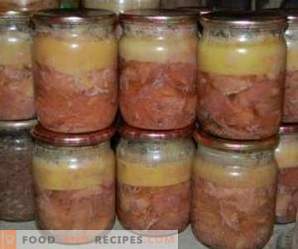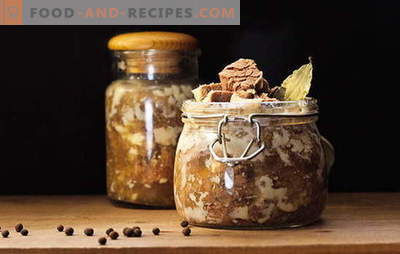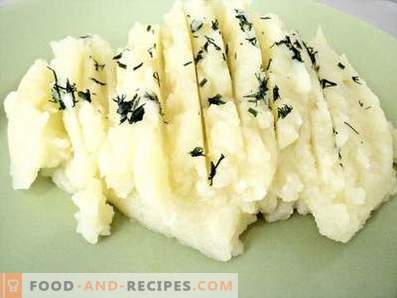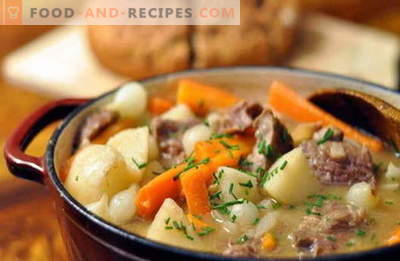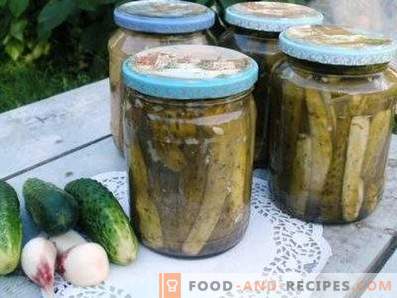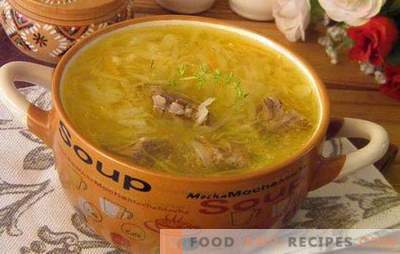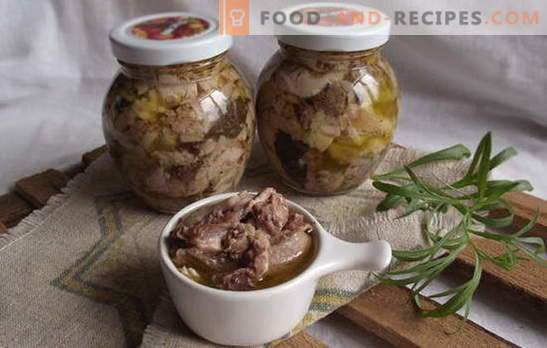
Beef stew at home - a great way to conserve meat.
As a result, you will get a delicious, and most importantly, natural meat product.
The stew is used to prepare second and first courses in cases where there is not enough time or opportunity to cook from fresh meat.
This is a finished product, so it is added at the very end.
Beef stew at home - the basic principles of cooking
To prepare the stew at home using fresh beef fillet. Frozen meat is absolutely not suitable. Beef does not contain enough fat, so add lard.
Beef stew cooked in a double boiler, jars, pressure cooker, autoclave, oven, multi-cooker, etc.
Canned stew is better in a liter or half-liter glass container, which is rolled iron lids. Glass containers and lids are pre-sterilized in the oven or above steam. To keep the stew long, all utensils must be sterile.
Beef is cut into large, equal pieces, salted and mixed. At the bottom of the cans spread pepper and bay leaves. Banks fill with meat and add internal fat or fat.
Filled jars are covered with tin lids and put on a baking sheet covered with coarse salt. Baking tray is sent to the oven heated to 200C for two hours. Then the stew is removed and rolled up with sterile caps.
Recipe 1. Beef and pork stew at home in a pressure cooker
Ingredients
600 g of beef;
1 bay leaf;
2 onions;
300 ml of broth;
7 peppercorns per jar;
1 clove of garlic per jar;
1 carrot;
5 g of salt per jar;
600 grams of pork;
fat.
Method of preparation
1. Put jars and lids in the oven or over the steam. Dry the sterile container well. Wash pork and beef under the tap, dry and cut in small bars. 2. Cut the bacon into thin slices. Onions free from the husk, and chop it into thin quarter-rings. Peel carrots, wash and cut into thin strips.
3. At the bottom of each jar, place a bay leaf, some salt, peppercorns, a clove of garlic and a couple of slices of bacon. Pour in just a little broth. Tightly lay pieces of meat in jars. Layering over beef with pork. Cover the glass container with the lids and place it in a pressure cooker. Pour water so that it reaches the shoulders of the cans.
4. Put the pressure cooker on fire. As soon as the water boils, twist the fire to minimum and leave to boil for three hours. Open the steam cooker only after complete cooling. If you do this right away, the banks will burst from the pressure drop.
Recipe 2. Beef stew at home in the oven
Ingredients
five kg of young beef;
black pepper;
half a kilo of pork fat;
coarse salt;
12 bay leaves.
Method of preparation
1. Wash and dry the beef with paper towels. Slice the meat along the fibers rather coarsely. Put everything in a bowl, pepper, salt and mix. Cut pork fat into small chunks.
2. Liter cans are thoroughly washed with soda and sterilized in the oven or above steam. Covers also need to be sterilized. Dry the glass containers well. At the bottom of each can put a bay leaf, three slices of bacon and 10 peas of black pepper. Then lay out the meat tightly, lightly tamping it. Banks should not be filled to the top.
3. Cover the cans with beef tin lids and press them down with a load so that they do not rise during the boiling process. Place the meat dishes in the cold oven. Heat it until the contents in the jars begin to boil and reduce the temperature to a minimum. Simmer the meat for about six hours.
4. Transfer the stew to a clean, sterilized, half-liter glass container and roll iron lids. Banks turn over, wrap and cool completely. Store jars in the refrigerator for up to six months.
Recipe 3. Beef stew at home in an autoclave
Ingredients
fat beef - two kg;
black and allspice peas;
turnip onions;
Bay leaf;
carrot;
15 grams of coarse salt.
Method of preparation
1. We wash the beef under running water, we clean the meat from the films and the veins. Drain it with paper towels and cut into chunks of medium size.
2. We clean vegetables and wash. Take the amount of vegetables at your discretion. Onion cut into rings. Shred carrots thin circles.
3. Liter cans are well washed and sterilized over steam or in the oven. Then we dry the tara well. At the bottom of each jar we put sweet and black pepper and bay leaves. Fill the jar with meat, lightly tamping it, while not filling them to the top. Top pour a teaspoon of coarse salt.
4. We roll the cans with tin lids, after having sterilized them. Place the meat container in the autoclave and fill it with water so that it completely covers the meat.
5. Set the autoclave to an initial pressure of 1.5 atmospheres. We put it on fire and wait until the pressure reading reaches 4 atmospheres. Cooking stew for five hours. Then we give the banks to cool completely in the autoclave, remove and store for storage in a cool place.
Recipe 4. Beef stew at home in a slow cooker
Ingredients
one and a half kg of young beef;
two pinches of dried rosemary and black pepper;
6 g of salt;
bay leaf - 5 pcs.
Method of preparation
1. Wash beef under running water, cut off the film and cores. Cut it into small pieces, two centimeters thick and put them in a multicooker container.
2. Do not add water! Suck out enough meat from the meat. Include on the multicooker program “Quenching”. Set the timer to seven o'clock. Time adjust depending on the meat. If the meat is young, five to six hours is enough. 3. Leave the meat alone for three hours. Do not often open the lid, otherwise the liquid will evaporate. After three hours, check the condition of the meat. If the liquid is evaporated, add a little water. Close the lid and simmer the beef for another two hours.
4. Add all spices to the multicooker container, mix and continue cooking for another hour. Check the meat for salt, if necessary, salt it.
5. Wash half-liter glass containers and sterilize over steam or in the oven. The finished stew spreads on the banks, lightly tamping. Top pour all the melted fat. For long-term storage, put the banks, covered with lids, on a baking sheet. Sterilize at 200 degrees for half an hour. Then roll up sterile tin lids.
Recipe 5. Beef stew at home in a cauldron
Ingredients
beef with fat - three kg;
coarse salt;
bay leaf - 15 pcs .;
ground white pepper;
onions - six heads;
black pepper peas - 20 pcs.
Method of preparation
1. My piece of beef under the tap, cut off the film and core and dry it with a paper napkin. Meat cut quite large.
2. Peel the bulbs, rinse and cut them into quarters.
3. We lay out in a cauldron in layers: pieces of beef, salt and pepper, half of bay leaves and peppercorns, quarter onions. Repeat the layers in this order until all the meat ends.
4. Cauldron close tightly with a lid and set on fire. We try not to miss the moment when the juice that gave the meat does not begin to boil. Mix the contents of the cauldron and twist the fire to the weakest. We continue to extinguish, covered with a lid for another hour. Mix again and leave for another hour. More meat do not mix. Sometimes we check that the contents of the cauldron is weakly boiling.
5. Tomim stew still half an hour. This stew is not intended for long-term storage, so we place it in a container and send it in the fridge.
Recipe 6. Beef stew at home in a water bath
Ingredients
800 grams of beef;
bay leaf - 3 pcs .;
200 g of lard;
salt - 5 g;
7 g ground black pepper.
Method of preparation
1. Wash a piece of beef under the tap, clean it from veins and films. Drain the meat with paper towels and cut into pieces like skewers.
2. Cut the pork fat as small as possible so that it is well heated and gives the stew tenderness.
3. Put the lard and beef in a deep dish. The ratio of meat and fat should be about 4: 1, that is, take four pieces of meat to one part of lard.
4. Season the meat with salt and ground black pepper and mix well with your hands.
5. Banks wash and sterilize. Put the meat mixture into the jars, lightly tamping. Put a bay leaf on top. Banks should not be filled to the top.
6. At the bottom of the wide pan, place the can rack. Put a jar of meat on it and fill it with cold water so that it reaches the jar's hanger. Cover the jar with a lid and screw it slightly. Put the pot on the fire, wait until the water boils, twist the fire to minimum and cook the stew at a slow boil for about six hours. As the water boils out, gently top it up. Remove the finished stew, twist the lid to the end. Store the stew in the refrigerator for no more than six months.
Recipe 7. Beef stew at home without fat
Ingredients
two kg of beef tenderloin;
ground black pepper;
beef tallow;
eight bay leaves;
salt;
black pepper peas - 30 pcs.
Method of preparation
1. Prepare a glass container for preservation. Wash it and sterilize it. At the bottom of the cans lay out several black peppercorns and one bay leaf.
2. Wash the beef under the tap and cut it into pieces, the size of a matchbox. Lay the meat tightly in jars. Layers salt pepper. Fill the jar on the neck, leaving a couple of centimeters from the edge. Top bay leaves and peppercorns. 3. Beef fat cut into small pieces and put on top of the meat. Sheet the foil folded in half and cover them with the neck of the jar. Put the tara with meat on a baking sheet, pour cold water into it. Put the pan in a cold oven. Turn on the temperature at 120C. Cook the stew for eight hours.
4. After this time, almost all the liquid should evaporate from the cans. Turn off the oven and cool the stew without taking it out. Remove the foil and close the jar lids.
Beef Stew at Home - Tips and Tricks
- If you are cooking the stew in the oven, on a baking sheet on which the cans will stand, pour the water or sprinkle it with salt. This is necessary in order not to burn the fat that can flow out of the jar.
- In order for the stew to not turn out dry, be sure to add lard or internal fat.
- Cook the stew only in a sterile glass container.
- To prevent the lid from oxidizing from the inside, grease it with grease.
- Store meat in a dark, cool place. If all cooking conditions are met, the stew can be stored for up to five years.
